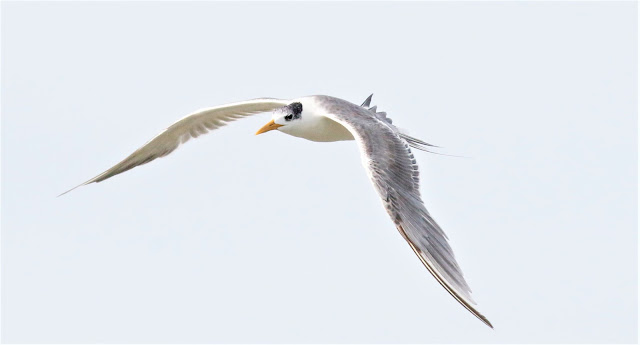A flock of Eurasian Curlew
 |
| Great Crested Tern |
 |
| Pacific Golden Plover |
 |
| Whiskered Tern |
 |
| Little Tern |
Great Knot in flight
Initially i thought this could be a Black-naped Tern but the photo was taken near shore and its tail wasn't really forked. So it was most likely a Whiskered Tern with an enormous looking wing span.
Asian Dowitcher in flight
The above photo was taken in March 2017 showing some breeding feathers of Bar-tailed Godwit.
A flock of Caspian Tern and a lone Eurasian Curlew returning to their evening roost.
Mixed flock of shorebirds.
It doesn't matter who is front of the pack as everyone will just follow the lead.
Do all birds always fly in "V" shape formation?
Many reasons were mentioned by the literature on why some birds fly in "V" shape formation. Some says it was for leveraging on the uplifting drift produced by close-by birds while some states that it was for the ease of communication.
On the reason for ease of communication, it would be interesting if we could decipher the meaning of "krak krak" [ "Are you guys ok behind"? - bird (i) ], or "tutututu" [ "we are right above you" - bird (ii) ] or "chew chew chew" [ "we are right behind you" - bird (iii) ] or "teu teu teu" [ "i am just below you, please don't pee" - bird (iv) ]
However not all birds fly in a "V" shape formation as i have observed recently. The bird species which i was referring to are the Black-Tailed Godwit (Limosa Limosa). Have a look below:
All the above pictures were taken near shore and no where near their migration routes. So there is also a possibility that they might revert to "V" formation during their migration journey. More observations are required in this area.
Some of the shore birds do at times look like big vampire bats.
 |
| White-Bellied Sea Eagle |
Technically these White-Bellied Sea Eagle (Haliaeetus leucogaster) can't be considered as a shorebird but because they are usually found near the shore line, i just needed to include them here.
HAPPY BIRDING !




































